"We are what we repeatedly do. Excellence, then, is not an act, but a habit." --Aristotle
Address any questions or comments regarding this newsletter to the individual authors listed after each article or to its editor, Rick Weinzierl, 217-333-6651, weinzier@illinois.edu. To receive e-mail notification of new postings of this newsletter, call or write the same number or address.
In This Issue:
Upcoming Programs (listings for beginning and established growers)
Regional Reports (from southern and western Illinois)
Fruit Production and Pest Management (cane and crown borers in brambles, degree-days and control of codling moth and oriental fruit moth; eastern flower thrips on strawberries)
Vegetable Production and Pest Management (preventing seedling death in cucurbits, insects on cabbage family crops, corn earworm / tomato fruitworm moth flight at Urbana )
Upcoming Programs
Check the Illinois SARE calendar for a full list of programs and links for registration.
http://illinoissare.org/ and http://illinoissare.org/calendar.php
Also see the University of Illinois Extension Local Food Systems and Small Farms Team's web site at:
http://web.extension.illinois.edu/smallfarm/ and their calendar of events at http://web.extension.illinois.edu/units/calendar.cfm?UnitID=629.
- Southern Illinois Summer Twilight Series Meeting, May 18, 2015. 6:00 p.m. at Miller Farms, 918 Calvary Cemetery Rd, Campbell Hill, IL 62916. Visit a diverse farm operation that includes plasticulture strawberries, low tunnel tomatoes, blueberries, cover crops, egg production, and more. Program is free but pre-registration is required by Friday, May 15 at https://web.extension.illinois.edu/registration/?RegistrationID=12224 or by phone at 618-382-2662. For more information about the Twilight Meeting go online or contact: Bronwyn Aly at baly@illinois.edu; 618-382-2662 or Nathan Johanning at njohann@illinois.edu; 618-687-1727.
- No-Till Vegetable Production Clinic, May 20, 2015. 4:00 – 6:00 p.m. at the Jackson County Extension Office at 402 Ava Rd., Murphysboro, IL. For more information, call the Jackson County Extension Office at 618-687-1727. The registration fee is $5.00 per person. Pre-registration is required by May 19, 2015, online at https://web.extension.illinois.edu/registration/?RegistrationID=12393 or by phone at 618-687-1727.
- Southwestern Illinois Twilight Orchard Meeting, May 21, 2015. Weigel Orchard near Golden Eagle, IL, 5:30 – 7:30 p.m. For more information, contact Ken Johnson at 217-243-7424 or kjohnso@illinois.edu.
- Midwest Compost School, June 2-4, 2015. Wauconda Township Hall, Lake County, IL. For more information, contact Duane Friend at friend@illinois.edu or 217-243-7424. Register at http://extension.illinois.edu/go/midwestcompost.
- Illinois Summer Horticulture Day, June 11, 2015. 8:45 a.m. – 3:00 p.m. at Boggio's Orchard and Produce, 12087 IL Highway 71, Granville, IL 61326. Registration begins at 8:00 a.m. Advance registration is $25 and includes lunch. More information about Boggio's Orchard and Produce is available at www.boggiosorchardandproduce.com. Event information is available at http://www.specialtygrowers.org/illinois-state-horticultural-association.html. For questions and reservations, email Rachel at ilsthortsoc@gmail.com or call 217-853-6048.
Regional Reports
From southern Illinois ... We had rain over the weekend, mainly Saturday morning and then Sunday afternoon into Monday morning. Overall, most saw around 2 inches, with 1.8 inches at the Extension Office in Murphysboro. However, just to the north I had reports of around 5.5 inches in the Campbell Hill area in northern Jackson County and Randolph County. Prior to these rains, we were actually in need of some rain as it had been over 2 weeks since the last significant precipitation.
Many warm-season vegetable transplants are going out into fields, especially tomatoes and peppers. High- and low-tunnel tomatoes are looking good, with some growers expecting first harvests in 2 weeks if the weather cooperates. Potatoes are up and growing, and asparagus harvest continues.
Early blackberries are in late bloom, with the later-maturing varieties just hitting bloom now. Blueberries are past bloom with the exception of a few late varieties and have lots of fruit set. We are in the midst of harvest of plasticulture strawberries. So far fruit quality is very good and yields are also very good, with growers hoping for more sun and less rain in the forecast to ripen the fruit and get customers out to the field. 'Camarosa' is one of the main varieties that is in harvest now. Some newer varieties that growers in southern Illinois are trying include 'Sweet Ann,' 'San Andreas,' and 'Albion.'
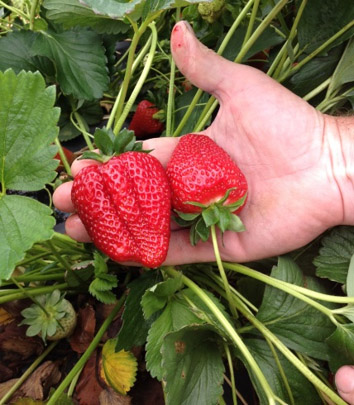
'Sweet Ann' strawberries at Miller Farms. (Photo by Nathan Johanning)
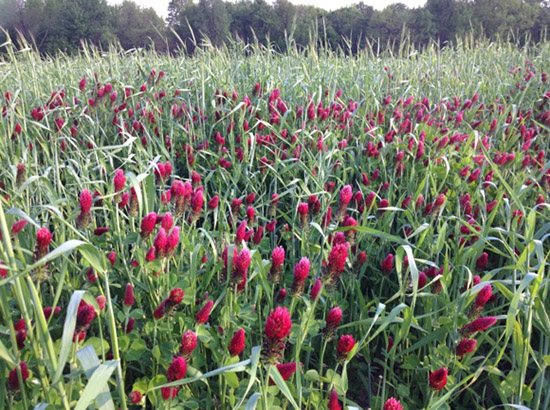
Crimson clover and cereal rye cover crop mixture at Rendleman Orchards. (Photo by Nathan Johanning
Cover crops have also taken off very well this spring. In plots at the Jackson County Extension Office, I have an early maturing cereal rye that is 5 - 6 feet tall, starting to flower, and ready to be terminated. This is about 2 weeks ahead of other cereal rye and triticale that are just starting to head. Crimson clover is nearing the end of bloom. Overall, spring cover crop growth and performance has been very good.
Nathan Johanning (618-939-3434; njohann@illinois.edu)
From western Illinois ... Some much-needed rainfall finally came near the end of last week. I received 1.25 inches, and before that our total precipitation since April 1 had been 2 inches. Soils were dry enough that some producers had quit planting due to insufficient soil moisture to germinate seeds.
The heat of the past week accelerated growth of plants and germination/emergence of seeds. High-tunnel tomatoes enjoyed the heat and sunshine of last week. Many have several sets of flowers, with at least one set of tomato fruit. Early squash and cucumbers (high tunnel and outside with protection) are flowering and fruiting. Succession plantings of sweet corn were uninterrupted throughout April and May until the rains of late last week. Green bean and other warm-loving seeds had very quick emergence. Although with the dry soils, deeper than normal planting was necessary in order to hit adequate soil moisture.
Transplants were still being and some seeding was taking place before the rains. It will be a few days before much field work can take place again, but as dry as the soils were, we won't be out for long. Those who had applied pre-emerge herbicides need to watchful of efficacy. The largest rainfall we received during April was 0.6 inches. Most all these products require incorporation within a certain time frame, either through tillage or via rainfall, and for some of these products applied after planting, we may have reached a critical time before rains occurred to provide necessary incorporation.
The largest apples here are about a nickel in size. Peaches are about the size of a quarter. We picked just a few plasticulture berries over the weekend, and with the cool temperatures the next few days, we don't envision many coming on this week. Matted row strawberries range from 10% bloom for the late maturities to bloom nearly completed and some small green berries on the earlier maturities. High tunnel strawberry harvest has been ongoing. Blackberries survived the winter well and are blooming, and blueberries are beginning to bloom as well.
Asparagus harvest has been steady, and the heat of last week accelerated growth tremendously. We've been picking for a little over one month and will conclude this years' harvest shortly. As a reminder, the rule of thumb is to pick until the majority of spears are pencil size diameter, then retire the patch for the year. Keep the patch clean by picking those smaller diameter spears and not allowing them to fern out. It's much easier to treat the entire patch than to segregate out individual plants. The spears are using stored energy to develop, and as that energy is expended, the plant becomes weaker, thus the smaller diameter of spears. It's not to the benefit of the plant to continue to harvest as spear size diminishes. A weak plant is more susceptible to pests and continued stress can lead to a shorter lifespan.
The 2015 Midwest Vegetable Production Guide lists herbicides labeled for asparagus. Choose a residual herbicide to provide length of weed control, but also consider the use of a non- selective herbicide to control existing weeds. Glyphosate (Roundup) can provide better control of emerged perennial weeds than paraquat (Gramoxone). Use caution if you select glyphosate, as this product is systemic within plants (both the weed and the crop). Either apply immediately after the last picking (to avoid contact with emerged spears) or mow off the asparagus before application. Gramoxone (which is not systemic) can be applied immediately after last picking, avoiding contact with emerged spears. Fertilization can also occur at this time ... use 50-70 pounds per acre of nitrogen and enough phosphorus and potassium to maintain a level of 40-50 pounds/acre of phosphorus and 300+ pounds/acre of potassium.
Mike Roegge (217-223-8380; roeggem@illinois.edu)
Fruit Production and Pest Management
Rednecked Cane Borer and other Cane and Crown Borers in Brambles
Earlier this month the University of Illinois Plant Clinic received a sample of blackberry canes damaged by and infested with rednecked cane borers. So ... this may a good time to review the life histories and control of the various borers that infest raspberries and blackberries.
Rednecked cane borer is a beetle; the adult stage is known as a metallic wood boring beetle, and larvae are called flat-headed wood borers. This insect has 1-year life cycle. Beetles feed on leaf margins from May through August and lay eggs in bark of new growth, usually within 10 inches of the base of canes. Larvae tunnel through canes and reach full size by fall. They pupate in the spring, and adults emerge in May. Damage to canes is characterized by tunnels that spiral around the cane and by symmetrical swellings or galls 1-4 feet above the soil line. Pruning out and destroying galled canes is recommended for rednecked cane borer control. If more than 5% of canes are galled, a postbloom drench application of Admire Pro to soil for systemic uptake and control may be warranted. Do not apply Admire Pro prebloom or during bloom. Brigade applied to the base of canes when adults are active will give some adult control ... to avoid bee kill, do not apply when plants are in bloom and bees are foraging.
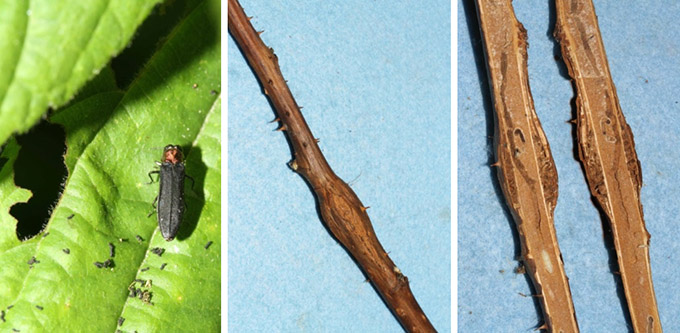
Left: Rednecked cane borer adult and feeding damage on foliage. Center: Gall caused by rednecked cane borer larva. Right: Tunneling inside cane by rednecked cane borer larva. (Photos by Phil Nixon)
A somewhat similar insect, raspberry cane borer, is a longhorned beetle; the larval stage is known as a round-headed wood borer. Raspberry cane borer has a 2-year life cycle. Beetles feed on canes from June through August, and they lay eggs between rings of punctures on canes. Larvae tunnel to the base of canes by fall. They feed in crowns during their second summer, then pupate the following spring; adults emerge from June through August. To control raspberry cane borer, prune out and destroy infested canes, beginning in July. Foliar sprays of insecticides labeled against other bramble pests (including Brigade and Sevin) give some control of adults from late May until mid-July, but applications must be timed to avoid bee kill.

Raspberry cane borer adult, girdling and egg-laying puncture, wilted cane, and larva. (Photos from NRAES-35, Bramble Production Guide)
A third boring insect (as in tunneling, not as in dull and tedious lectures and newsletter articles), is the raspberry crown borer. It is a clear-winged moth, and its larval stage is a caterpillar with fleshy abdominal prolegs that bear hook-like "crochets." It also has a 2-year life cycle. Moths fly from August through September and lay their eggs on the undersides of leaves; eggs hatch in September and October and move down the canes to the crown. In their first fall, larvae form a hibernaculum below the soil line; they girdle canes and crowns the next summer before wintering in roots. They finish development and pupate in the second summer. To control this insect, apply a drench of Altacor, Brigade, or Hero to the crowns in a minimum of 50 gallons of water per acre after egg hatch in October or November or in late March. Time the application to precede irrigation or a significant rainfall. Biological control by drench application of insect-pathogenic nematodes (Steinernema feltiae) also is possible. Removing infested crowns is also recommended.
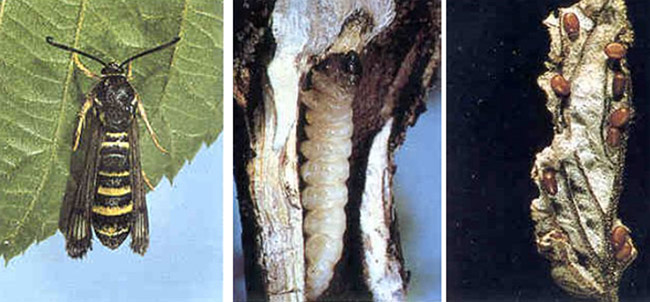
Raspberry crown borer adult, larva, and eggs. (Photos from NRAES-35, Bramble Production Guide)
For more information on these insects and listings of insecticides registered to control them, check the Midwest Small Fruit Pest Management Handbook and the 2015 Midwest Small Fruit and Grape Spray Guide.
Rick Weinzierl (217-244-2126; weinzier@illinois.edu)
Pheromone Traps, Degree-Days, and Control of Oriental Fruit Moth and Codling Moth
The biofix date (first consistent capture of male moths in pheromone traps) for oriental fruit moth at the University of Illinois orchard at Urbana was April 18; biofix for codling moth here was May 5. Using the Illinois State Water Survey Degree-Day Calculator, degree-day accumulations for oriental fruit moth (base 45F) here since April 18 are 360 through May 5. Degree-day accumulations for codling moth (base 50F) at Urbana since May 5 are 147.

Oriental fruit moth adult, flagging damage to new shoot, and larva in fruit. (Photos from Washington State University)
For oriental fruit moth, first-generation larvae typically infest new shoots in peaches and nectarines, and although their tunneling and feeding cause shoots to flag, this damage is usually not severe. Consequently, when insecticides are applied at shuck split and in first cover sprays (when at least a portion of first-generation larvae would be controlled), the insecticides are usually chosen for effectiveness against plum curculio or against stink bugs and plant bugs. Second- and third-generation oriental fruit moth larvae infest the fruits of peaches and nectarines (and other fruits) and are specifically targeted for control using mating disruption or insecticides. Where mating disruption is used (as it is in Calhoun County), pheromone dispensers need to be in place before the start of second-generation flight (by no later than 900 degree-days base 45 F after the biofix date for the first generation flight). Where insecticides are used to protect fruit, the key timing for application is 400 to 600 days after the beginning of the second and third flights. See page 36 of the 2015 Midwest Tree Fruit Spray Guide for a list of insecticides registered for oriental fruit moth control in peaches. Oriental fruit moth populations in Calhoun County and perhaps other areas have developed resistance to pyrethroid insecticides (including Asana, Baythroid, Renounce, Pounce, Actara, Mustang Max, Warrior, Proaxis, and Danitol) ... these products and others that contain the same active ingredients will control the resistant populations.
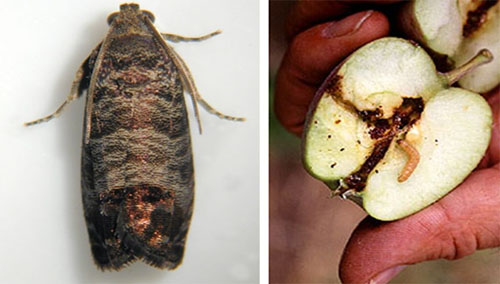
Left: codling moth adult (Photo from University of Minnesota). Right: codling moth larva (Photo from Utah State University)
For codling moth, 2 to 3 generations infest apples each year. First-generation larvae begin to hatch from eggs and enter fruits about 220-240 degree-days (base 50F) after the biofix date. To protect fruit from first-generation larvae, insecticides need to kill eggs or larvae before larvae enter fruit. Recommended timing for several insecticides used for first-generation codling moth control on apples and pears is listed in the table below (a screen shot from page 23 of the 2015 Midwest Tree Fruit Spray Guide). (Some of these insecticides are labeled for use only on pears, not apples ... be sure to check the Spray Guide and product labels for details.)
Timing of Firsta Insecticide Spray for Codling Moth Control on Apple and Pear |
|
|---|---|
Degree-days (base 50°F) after biofixb |
Insecticide Products |
50-75 |
Dimilin |
100-200 |
Intrepid |
150-250 |
Calypso |
250 |
Imidan |
aA second spray should be made 10-14 days later. |
|
Rick Weinzierl (217-244-2126; weinzier@illinois.edu)
Eastern Flower Thrips on Strawberries
Quick reminder ... as strawberries bloom and berries begin to enlarge, they are vulnerable to damage from feeding by eastern flower thrips. The eastern flower thrips is a tiny, yellow to brown insect less than 1/16 inch long. Adults are attracted to flowers of many different plants; their rasping feeding causes premature wilting of flower parts and blossom drop, as well as fruit deformities in some crops. Although this insect does not overwinter outdoors in Illinois, survival in greenhouses is presumed to occur, and populations develop each year throughout the state as a result of long-distance migrations from southern states on high-level winds associated with weather fronts. Immigration of thrips may occur simultaneously with immigration of the potato leafhopper.
To determine whether or not thrips control is warranted, strawberry growers should begin sampling for thrips by examining early flower clusters on early varieties and continue sampling all varieties as they begin to bloom. Tap flowers onto a white or very dark plate or saucer, and look for the slender yellow thrips. Alternatively, flower blossoms can be placed into a zip lock bag and shaken to dislodge thrips and allow counting. Although the relationship between thrips density and damage appears to be influenced by variety and weather conditions, control is probably warranted if populations exceed 2-10 thrips per blossom. This is a broad range of densities, but more a more precise threshold has not been established. If insecticides are to be used for thrips control, make applications before bloom is well underway (by the time 10 percent of the plants have open blossoms) to avoid killing pollinators. Entrust (1) and Radiant (1) are labeled for thrips control in strawberries. Lorsban (21), Danitol (2), and Brigade (0) are not labeled specifically for thrips control in strawberries but have been effective in field use at rates listed for clipper or spittlebug and tarnished plant bug; numbers in parentheses indicate the minimum preharvest interval (PHI) that must elapse between the last application of each insecticide and the harvest of fruit. For more details, see the 2015 Midwest Small Fruit and Grape Spray Guide.
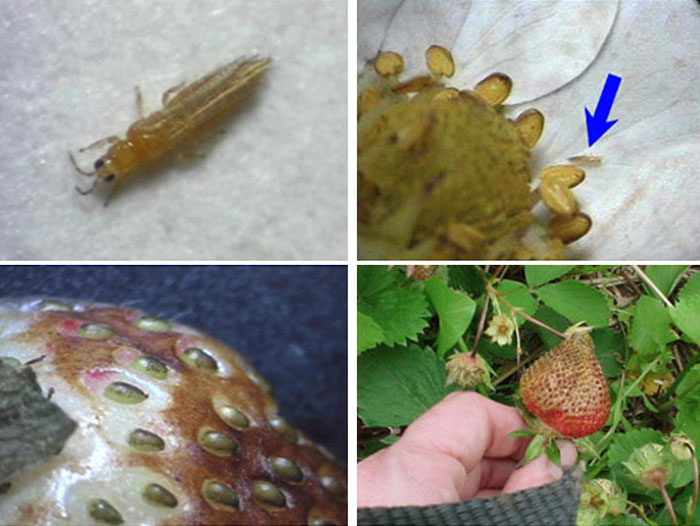
Top left: Adult eastern flower thrips; top right: thrips (at arrow) in strawberry blossom; bottom left: close-up of berry discoloration; bottom right: partially browned berry, likely caused by earlier feeding by eastern flower thrips. (Photos by Elizabeth Wahle
Rick Weinzierl (217-244-2126; weinzier@illinois.edu)
Vegetable Production and Pest Management
Cover Crop Notes: Terminating Cereal Grains
Cereal rye (winter rye), winter wheat, triticale and other small grains are very popular cover crops, especially for no-till vegetable production. Now that we've finally gotten in to more spring-like weather, many of these cover crops have really taken off, and it's time to plan for their termination.
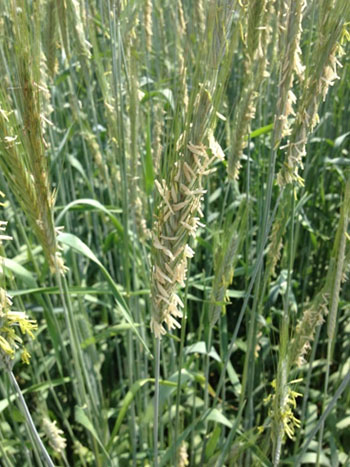
Cereal Rye at flowering (anthesis). (Photo: Nathan Johanning)
If you are mowing or using a roller/crimper, anthesis (pollination) is the best time to terminate. Anthesis or flowering is easily distinguished as the time when you see yellow anthers hanging from the head. This timing is recommended for these termination methods because at flowering the plant has switched from vegetative (stem/leaf) growth to reproductive growth, and because of this, regrowth from the base of the plant is very limited. Prior to flowering the plant is still trying to produce vegetation so you can get a significant amount of regrowth. This is especially important to note if you are not wanting or able (organic systems) to have to come back with herbicides to manage regrowth.
If you are strictly using herbicides (glyphosate) for termination you have more flexibility and can terminate earlier but make sure to spray shortly after pollination (milk stage) to prevent the formation of viable seeds.
Nathan Johanning (618-939-3434; njohann@illinois.edu)
Prevent Seedling-Death of Cucurbits
Damping-off is a common pre- and post-emergence disease of cucurbits in Illinois much of the world. Damping-off has been observed in cucumber, melon, pumpkin, summer and winter squash, and watermelon production. Pythium species, including P. ultimum, P. aphanidermatum, P. irregulare, and P. myriotylum, and Phytophthora species, including P. drechsaleri and P. capsici, have been identified as causal agents of damping-off of cucurbits. P. capsici is a major causal agent of damping-off (seedling death) in cucurbits, particularly jack-o-lantern and processing pumpkins, in Illinois. All of these species are oomycete pathogens. In general, all of these pathogens can be managed by the same practices.
In damping-off, a watery rot develops on the hypocotyl of the seedling at or near the soil line, resulting in plant death. Post-emergence plant death is preceded by plant wilting: a sudden, permanent wilt of the plant without a change in color of the foliage. Leaf wilting progresses from the base to the extremities of the vines. Plants often die within a few days of the first expression of symptoms or after soil is saturated by excessive rain or irrigation. The stems of infected plants turn light to dark brown near the soil line and become soft and water-soaked. Infected stems collapse and die. If the infection is caused by Phytophthora, the taproot and lateral roots of infected plants usually do not exhibit symptoms. Pythium species cause seedling death, as well as root rot. Phytophthora seedling death in pumpkin fields in Illinois may result in partial to total loss of the crop.
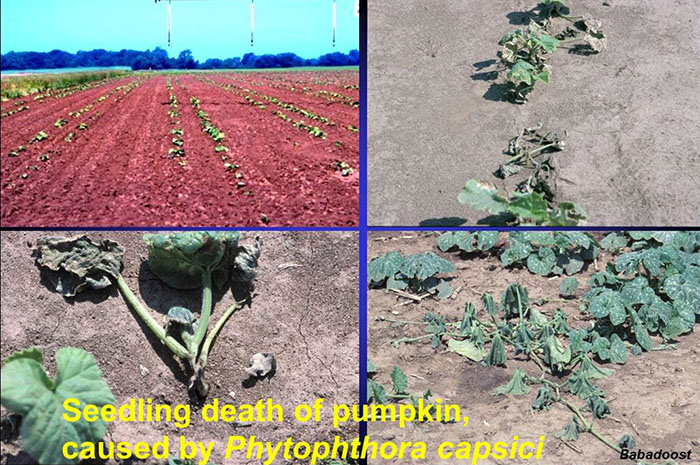
Fungicide seed-treatment can effectively prevent seedling death of cucurbits. Seed treatment with either mefenoxam (Apron XL LS at the rate of 0.42 ml /kg or 0.64 fl oz/100 lb of seed) or metalaxyl (Allegiance FL at the rate of 0.98 ml /kg or 1.5 fl oz/100 lb of seed) can protect seedlings of cucurbits against P. capsici for up to 5 weeks after planting. It is important to note that resistance P. capsici to both mefenoxam and metalaxyl has occurred in some areas of the United Sates, so the sensitivity of P. capsici populations should be tested before fungicide applications are chosen. No resistance in Illinois isolates of P. capsici to these compounds has been detected yet. In recent years, Apron XL LS has been used by pumpkin growers and practically eliminated seedling death of pumpkins in the fields.
Mohammad Babadoost (217-333-1523; babadoos@illinois.edu)
"Worms" on Cabbage and Related Brassica Family Plants
Technically speaking, "worms" is not a very accurate term, but many of us use it to refer to the collection of larvae of the Lepidoptera (butterflies and moths) that attack the foliage and heads of cole crops (cabbage, broccoli, Brussels sprouts, and cauliflower) and crucifer greens (mustard greens, turnip greens, collards, kale, and others). In most instances, the three "Leps" that are the culprits are imported cabbage worm, diamondback moth, and cabbage looper.
Imported cabbage worm overwinters as a pupa within a chrysalis in crop debris, and adults -- the common white cabbage butterflies -- begin flying in early spring. They have been on the wing for a few weeks now in much of the state. They lay bullet-shaped, ridged yellow eggs (individually, not in masses) on foliage. Larvae are velvet-green, and just over 1 inch long when fully grown; they tend to feed from the edges of the leaf, and large veins are left intact. The chrysalis that encloses the pupa is grayish green to bright green and suspended by threads from the underside of outer leaves. It usually takes 4 to 5 weeks for larvae to mature from the egg to the adult stage.

Imported cabbage worm larva and adult (cabbage butterfly).
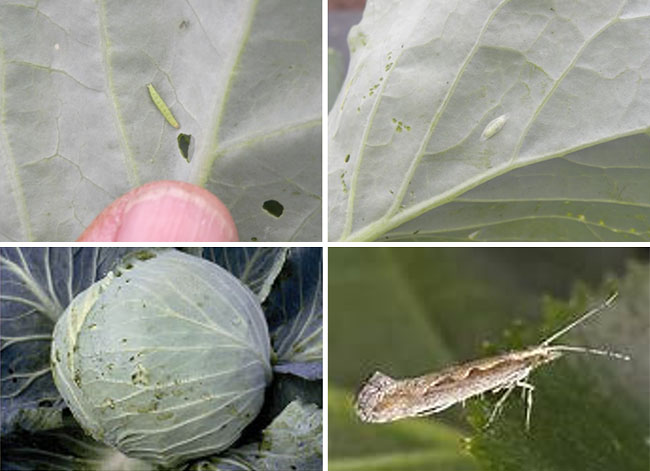
Clockwise from upper left: Diamondback moth larva, pupa, adult, and damage to cabbage.
The diamondback moth is the smallest of these three species. It winters in Illinois as an adult moth, though the portion that survives the winter is low in normal to severe winters. Eggs, larvae, and pupae may be introduced on transplants shipped in from southern regions, and northward migration of moths during the season also can extend its range. Flat, yellowish eggs are laid singly or in small groups, often near leaf veins or on stems, but they usually go unnoticed. Larvae initially mine between leaf surfaces, then they feed externally, often consuming all but the upper or lower epidermis, leaving a "window pane" effect. Fully grown, they are about 3/8 inch long. They pupate within a light silken cocoon on a leaf, and a small moth (1/2-inch wing span) emerges a week or so later. Each generation takes 3 to 4 weeks for growth and development, and there can be as many as 6 generations per year in Illinois.
The cabbage looper is the largest and most destructive of the three common Leps that attack cole crops here. This insect does not overwinter (at least not in significant numbers) in most of the Midwest; instead it migrates into the region on weather fronts, usually from June through September. Moths lay dome-shaped, ridged white eggs singly or in small masses on the underside of leaves. Larvae have only 3 pairs of abdominal prolegs (rear fleshy legs without joints) instead of the "normal" 5 pairs of many common Lepidopteran larvae. They grow to a length of 1 1/4 inch or more, and their feeding on leaves and heads can be very heavy. In addition, their frass (insect poop) is a less-than-sought-after contaminant. Each season, 2 to 3 generations of cabbage loopers develop in most of Illinois.
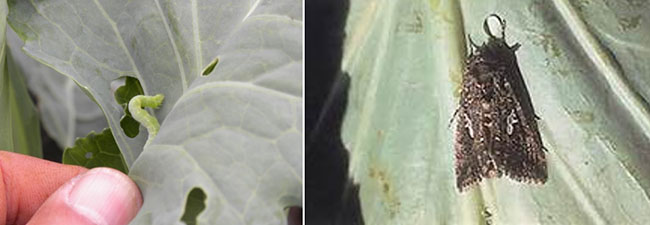
Cabbage looper larva and adult.
The simplest thresholds (and therefore the ones most often used by growers who scout their own fields) for these insects lump all species together, at least for determining the need for control. Growers should examine 10 plants per site in each of 10 sites in a field (more samples = more dependable conclusions), record each plant as infested (by any of the species) or uninfested, and use the following thresholds.
Thresholds for imported cabbage worm, diamondback moth, and cabbage looper: treat if infestations of any/all of the 3 species are found on more than the percentage of plants listed below. |
|
Crop and Stage |
Percent Infested Plants |
|---|---|
Broccoli and cauliflower |
|
Cabbage |
|
Collards, Kale, Mustard Greens, and Turnip Greens |
|
Early in the season, whenever control of flea beetles, aphids, and thrips is NOT needed, use Bt (Bacillus thuringiensis) applications to control these Lepidopteran larvae on crucifers. Bt products include Agree, Biobit, Dipel, Javelin, Lepinox, XenTari, and others. These Bt preparations must be eaten by caterpillars to be effective, and they are toxic only to larvae of butterflies and moths. They work well against imported cabbage worm and diamondback moth larvae and are effective enough against young cabbage looper larvae to keep most infestations below economic thresholds at least until heads are forming or present. Relying as much as possible on Bt products early in the season avoids killing natural enemies that help to keep these pests (especially diamondback moth) under control; it also reduces selection for resistance, especially in the diamondback moth, to pyrethroids and a few other insecticides that are valuable for use as cleanup sprays near harvest. Several insecticides are labeled for use against these pests in cole crops (cabbage, broccoli, etc.), but the list of included versus excluded crops gets pretty complex for leafy greens. Check the 2015 Midwest Vegetable Production Guide and product labels for specific listings. Where populations of diamondback moth show resistance to pyrethroids (or even to Bt), products with different modes of action include Avaunt, Coragen, Entrust, Intrepid, Proclaim, Radiant, and Rimon. Entrust is the OMRI-listed formulation of spinosad that can be used in organic production systems.
Also remember ... Flea beetles can be damaging especially on seedlings and leafy greens. A number of insecticides are effective for their control; see the 2015 Midwest Vegetable Production Guide. Onion thrips often move into cabbage as surrounding small grain fields dry down. Thrips are difficult to control in cabbage after they move between wrapper leaves. The time to treat is often at cupping or as heads begin to form. Brigade, Entrust, Mustang Max, Radiant, and Warrior are among the insecticides that are effective against onion thrips in cabbage.
Rick Weinzierl (217-244-2126; weinzier@illinois.edu)
Corn earworm / Tomato Fruitworm
We set up corn earworm traps on May 4 at Urbana and had captured 2-3 moths per trap per night through the first week. I suspect a light flight may be occurring or have occurred elsewhere in the state as well. Although there's no sweet corn out there in a vulnerable stage so early, growers with high-tunnel tomatoes and peppers probably should be looking for signs of infestation and damage.

Corn earworm (aka tomato fruitworm) adults and damage to tomatoes.
Rick Weinzierl (217-244-2126; weinzier@illinois.edu)
Less Seriously ...
... time to re-run a few favorites from the last several years ...
How many dogs does it take to change a light bulb?
- Golden Retriever: The sun is shining, the day is young, we've got our whole lives ahead of us, and you're inside worrying about a stupid burned out bulb?
- Border Collie: Just one. And then I'll replace any wiring that's not up to code.
- Dachshund: You know I can't reach that stupid lamp!
- Rottweiler: Make me.
- Boxer: Who cares? I can still play with my squeaky toys in the dark.
- Lab: Oh, me, me!!!!! Pleeeeeeeeeze let me change the light bulb! Can I? Can I? Huh? Huh? Huh? Can I? Pleeeeeeeeeze, please, please, please!
- German Shepherd: I'll change it as soon as I've led these people from the dark, check to make sure I haven't missed any, and make just one more perimeter patrol to see that no one has tried to take advantage of the situation.
- Jack Russell Terrier: I'll just pop it in while I'm bouncing off the walls and furniture.
- Old English Sheep Dog: Light bulb? I'm sorry, but I don't see a light bulb!
- Cocker Spaniel: Why change it? I can still pee on the carpet in the dark.
- Pointer: I see it, there it is, there it is, right there.....
- Greyhound: It isn't moving. Who cares?
- Australian Shepherd: First, I'll put all the light bulbs in a little circle...
- Poodle: I'll just blow in the Border Collie's ear and he'll do it. By the time he finishes rewiring the house, my nails will be dry.
Cat: "Dogs do not change light bulbs. People change light bulbs. So, the real question is: How long will it be before I can expect some light, some dinner, and a massage?" All of which proves, once again, that while dogs have masters, cats have staff.
University of Illinois Extension Specialists in Fruit and Vegetable Production & Pest Management
Extension Educators – Local Food Systems and Small Farms |
||
Bronwyn Aly, Gallatin, Hamilton, Hardin, Pope, Saline, and White counties |
618-382-2662 |
|
Katie Bell, Franklin, Jackson, Perry, Randolph, & Williamson counties |
618-687-1727 |
|
Sarah Farley, Lake & McHenry counties |
847-223-8627 |
|
Nick Frillman, Woodford, Livingston, & McLean counties |
309-663-8306 |
|
Laurie George, Bond, Clinton, Jefferson, Marion, & Washington counties |
618-548-1446 |
|
Zachary Grant, Cook County | 708-679-6889 | |
Doug Gucker, DeWitt, Macon, and Piatt counties |
217-877-6042 |
|
Erin Harper, Champaign, Ford, Iroquois, and Vermillion counties |
217-333-7672 |
|
Grace Margherio, Jackie Joyner-Kersee Center, St. Clair County |
217-244-3547 |
|
Grant McCarty, Jo Daviess, Stephenson, and Winnebago counties |
815-235-4125 |
|
Katie Parker, Adams, Brown, Hancock, Pike and Schuyler counties |
217-223-8380 |
|
Kathryn Pereira, Cook County |
773-233-2900 |
|
James Theuri, Grundy, Kankakee, and Will counties |
815-933-8337 |
|
Extension Educators – Horticulture |
||
Chris Enroth, Henderson, Knox, McDonough, and Warren counties |
309-837-3939 |
|
Richard Hentschel, DuPage, Kane, and Kendall counties |
630-584-6166 |
|
Andrew Holsinger, Christian, Jersey, Macoupin, & Montgomery counties |
217-532-3941 |
|
Extension Educators - Commercial Agriculture |
||
Elizabeth Wahle, Fruit & Vegetable Production |
618-344-4230 |
|
Nathan Johanning, Madison, Monroe & St. Clair counties |
618-939-3434 |
|
Campus-based Extension Specialists |
||
Kacie Athey, Entomology |
217-244-9916 |
|
Mohammad Babadoost, Plant Pathology |
217-333-1523 |
|